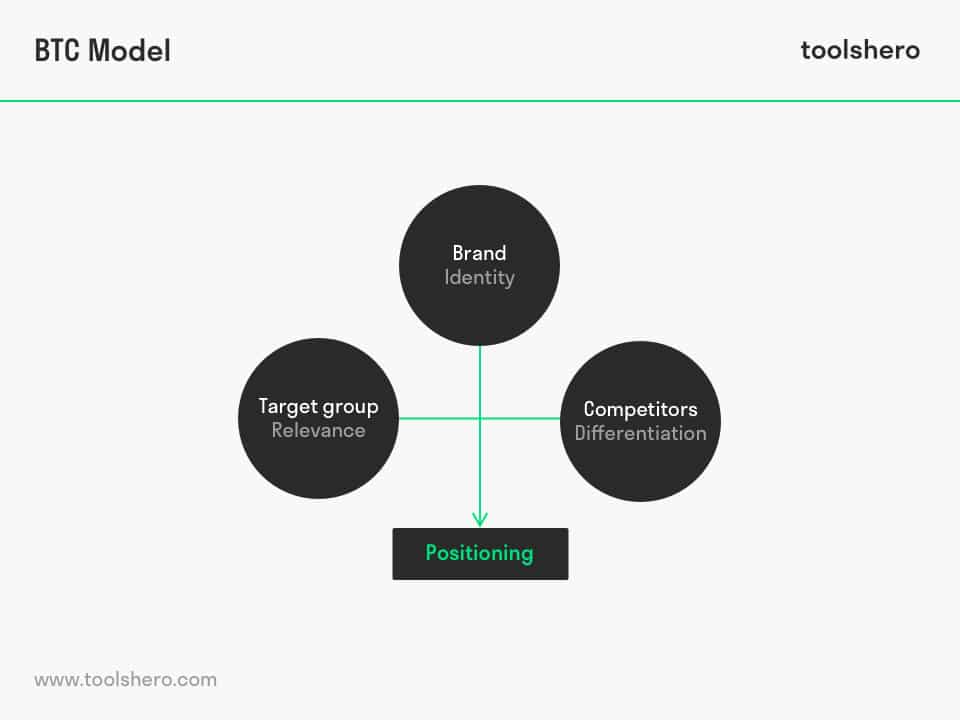BTC model

BTC model: this article provides a practical explanation of the BTC model. After reading, you will understand the basics of this powerful marketing tool.
What is the BTC model?
The acronym BTC stands for: Brand, Target group, and Competitors. The model serves as a useful tool for the positioning of a brand. Brand positioning is about how a brand stands out for customers and whether they are considering a purchase. Brand positioning ensures a unique impression is established in the minds of customers and the general market. Brand positioning must be unique, specific, clear, and indistinguishable from competitors.
The BTC model serves as a useful tool for positioning a brand. The idea behind the BTC model is that an organisation must first clearly communicate the identity of their brand. Subsequently, the organisation must make an informed decision as to which aspects of the identity should be emphasised.
The chosen aspects should be relevant and applicable to the target group. This is in fact the second component of the BTC model. The third component of the model is related to competitors. The organisation benefits greatly from knowing the position of the brand in relationship to its competitors.
The BTC model was developed by Rik Riezebos and Jaap van der Grinten.
BTC model and brand positioning
Brand positioning gives the target group a reason to purchase products of a certain brand instead of another. It ensures customers associate all the brand activities with the same feeling, and creates a common goal.
Brand positioning must further ensure that the brand is unique and distinctive compared to competitors. The organisation must also consider to what extent a brand, product, or service is important for a specific market. When positioning a brand, ask yourself the following questions:
- Is it sustainable? Can the brand image be sustained in the long term?
- Is the brand suitable for all major geographic markets and companies?
- Is it an effective way for the organisation to achieve its financial goals?
- Does the brand support and stimulate the organisation and its objectives?
In short, brand positioning more or less represents consumer opinions. It can be defined as an activity, process, or establishment of a brand in such a way that it occupies a distinctive place within the mind of the customer and the entire target audience.
At the same time, brand positioning is also about identifying and determining aspects or similarities in order to create a positive brand image.
Because brand positioning identifies exactly what customers value, it is the key to an effective marketing strategy. A strong brand position drives the marketing strategy on the basis of brand details, similarities with competing brands, and reasons for buying and using a specific brand.
Brand positioning using the BTC model lays the foundation for developing and increasing the required knowledge and perceptions of the customer.
BTC model: the Acronym
As stated above, BTC stands for Brand, Target group, and Competitors. The idea behind the model is that the identity of the brand must first be established, after which the organisation can make a well-considered decision as to which aspects should be emphasised. The same applies to the target group and competitors.
Brand
The brand refers to the identity of an organisation, and the brand can be related to an organisation, service, or product. For a corporate brand, its identity is often established by analysing the identity of the company as a whole. Based on this analysis, the organisation makes a final decision.
As for brands related to products or services, the brand identity consists of two layers. The first is the identity of the service or product itself, and the second is the identity of the underlying business. For organisations that have a clear vision and mission, the product or service identity is often an extension of the identity of the organisation as a whole.
Target Group
The second letter in the BTC model stands for Target group. This concerns the question of which particular aspects of the brand identity are relevant for a specific target group.
After all, not all aspects will be equally effective in convincing (potential) customers. Take an advertising company, for instance. Advertising companies usually have a traffic department.
A traffic department coordinates all of an organisation’s logistics processes. No company would use this in profiling, but a good traffic department is an important necessity. A traffic department does not add value to the positioning of the brand.
To determine which aspects of an identity lend themselves well to positioning a brand, an organisation may use a variety of tools, including the means-end analysis. This tool can expose the identity of a brand. At the same time, the tool provides useful insight into the language that the company should use with regard to customers and effective communication with the outside world.
Competitors
The third and final step in the BTC model is about determining a brand’s position compared to its competitors. Differentiation is a reoccurring theme here. After all, the question is how a company can design its products or services in such a way that customers ignore the competitor.
The consumer starts his customer journey with the demand for a certain product or service. It is important that a brand of service provider aligns its product or service with this demand. However, if an organisation focuses too much on differentiation, too much emphasis is quickly placed on the way in which the organisation distinguishes itself compared to other companies or brands. This is why it is better to talk about categorisation. This means a brand must be considered part of a category. In this case, customers may consider purchasing said brand.
To summarise
The BTC model by Riezebos and van der Grinten is an extremely effective tool for positioning a brand. Consisting of the brand, target group, and competitors, brand positioning forms the foundation for developing and increasing customer knowledge and perception. Brand refers to the identity of the organisation as a whole, or only the brand in itself.
The target group must be analysed to ensure effective communication, and to comply with their demands and wishes.
Finally, competitors must be analysed as well. After all, the goal of an organisation is to develop a quality product or service in such a way that consumers ignore competitors.
Now it’s your turn
What do you think? Are you familiar with the explanation of the BTC model by Riezebos and van der Grinten? How do you think you can apply this model when positioning your brand or organisation identity? What do you believe are factors that can influence brand positioning? Do you have any tips or additional comments?
Share your experience and knowledge in the comments box below.
More information
- Riezebos, R., & Van Der Grinten, J. (2012). Positioning the brand: an inside-out approach. Routledge.
- Riezebos, R., & van der Grinten, J. (2015). Positioneren: stappenplan voor een scherpe positionering. Boom Lemma.
How to cite this article:
Janse, B. (2019). BTC Model. Retrieved [insert date] from Toolshero: https://www.toolshero.com/marketing/btc-model/
Published on: 06/03/2019 | Last update: 06/02/2022
Add a link to this page on your website:
<a href=”https://www.toolshero.com/marketing/btc-model/”>Toolshero: BTC Model</a>













